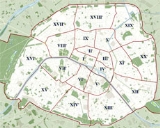
Rue Saint-Séverin, Paris
Encyclopedia
The rue Saint-Séverin is a sometimes boisterous street running parallel to the river in the north of Paris'
Latin Quarter
. Lined with restaurants and souvenir shoppes, much of its commerce is dedicated to tourism
.
, lies midway along this street's length.
and the rue Saint-Jacques
, it was later extended westwards from the former street to join the rue Saint-André des Arts. The rue Saint-Séverin reclaimed the remnants of the ancient rue du Macon upon the construction of the boulevard Saint-Michel
from 1867, but from 1971 this isolated westward portion was renamed the rue Francisque Gay.
Former Names: Between the rue de la Harpe
and the rue Saint-Jacques
, this street was called the "rue Colin Pochet" in the 16th century.
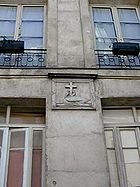 Even Numbers.
Even Numbers.
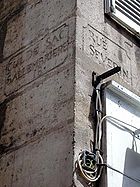
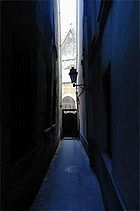
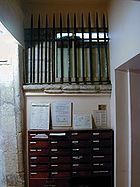
Paris
Paris is the capital and largest city in France, situated on the river Seine, in northern France, at the heart of the Île-de-France region...
Latin Quarter
Latin Quarter
Latin Quarter is a part of the 5th arrondissement in Paris.Latin Quarter may also refer to:* Latin Quarter , a British pop/rock band* Latin Quarter , a 1945 British film*Latin Quarter, Aarhus, part of Midtbyen, Aarhus C, Denmark...
. Lined with restaurants and souvenir shoppes, much of its commerce is dedicated to tourism
Tourism
Tourism is travel for recreational, leisure or business purposes. The World Tourism Organization defines tourists as people "traveling to and staying in places outside their usual environment for not more than one consecutive year for leisure, business and other purposes".Tourism has become a...
.
Name Origin
One of Paris' oldest churches, the Église Saint-SéverinSaint-Séverin (Paris)
The Church of Saint-Séverin is a Roman Catholic church in the Latin Quarter of Paris, located on the lively tourist street Rue Saint-Séverin...
, lies midway along this street's length.
History
The rue Saint-Séverin is one of Paris' oldest streets, as it dates from its quarter's creation in the early 13th century. At first existing only between the rue de la HarpeRue de la Harpe, Paris
The rue de la Harpe is a street in Paris' Latin Quarter. Relatively calm and cobblestoned along much of its length, it runs in a south-easterly direction between the rue de la Huchette and the rue Saint-Séverin, where it turns south-west to where it ends at the boulevard Saint-Germain...
and the rue Saint-Jacques
Rue Saint-Jacques, Paris
The Rue Saint-Jacques is a street in the Latin Quarter of Paris which lies along the cardo of Roman Lutetia. The Boulevard Saint-Michel, driven through this old quarter of Paris by Baron Haussmann, relegated the roughly parallel rue Saint-Jacques to a backstreet, but it was a main axial road of...
, it was later extended westwards from the former street to join the rue Saint-André des Arts. The rue Saint-Séverin reclaimed the remnants of the ancient rue du Macon upon the construction of the boulevard Saint-Michel
Boulevard Saint-Michel
The Boulevard Saint-Michel is one of the two major streets in the Latin Quarter of Paris . It is a tree-lined boulevard which runs south from the pont Saint-Michel on the Seine river and the Place Saint-Michel, crosses the boulevard Saint-Germain and continues alongside the Sorbonne and the...
from 1867, but from 1971 this isolated westward portion was renamed the rue Francisque Gay.
Former Names: Between the rue de la Harpe
Rue de la Harpe, Paris
The rue de la Harpe is a street in Paris' Latin Quarter. Relatively calm and cobblestoned along much of its length, it runs in a south-easterly direction between the rue de la Huchette and the rue Saint-Séverin, where it turns south-west to where it ends at the boulevard Saint-Germain...
and the rue Saint-Jacques
Rue Saint-Jacques, Paris
The Rue Saint-Jacques is a street in the Latin Quarter of Paris which lies along the cardo of Roman Lutetia. The Boulevard Saint-Michel, driven through this old quarter of Paris by Baron Haussmann, relegated the roughly parallel rue Saint-Jacques to a backstreet, but it was a main axial road of...
, this street was called the "rue Colin Pochet" in the 16th century.
Constructions of note
Odd Numbers.- 7, 9, 11 - Buildings dating from the 17th century.
- 13 - Building still having its "name sign" that predated addresses - this one "La Cygne de la Croix" (a play-on-words of "the sign of the Cross").

- 4 - Engraving of streetname on building corner. "St" scratched away.
- 6 - Alleyway existing (and already barricaded) in 1239.


- 8 - Door and alleyway dating from the 16th century.

- 20 - 17th-century "rotisserie" (grill).
- 22 - 17th century hotel.
- 24-26 - Street name engraved on building corners; the "St." on both was scratched away after the 1789 revolution.
- 34 - Building dating from the 17th century. Remarkable doorway, arch engravings, courtyard and stairway (therein).
- 36 - Building known as l'auberge de "l'Étoile" in 1660.

